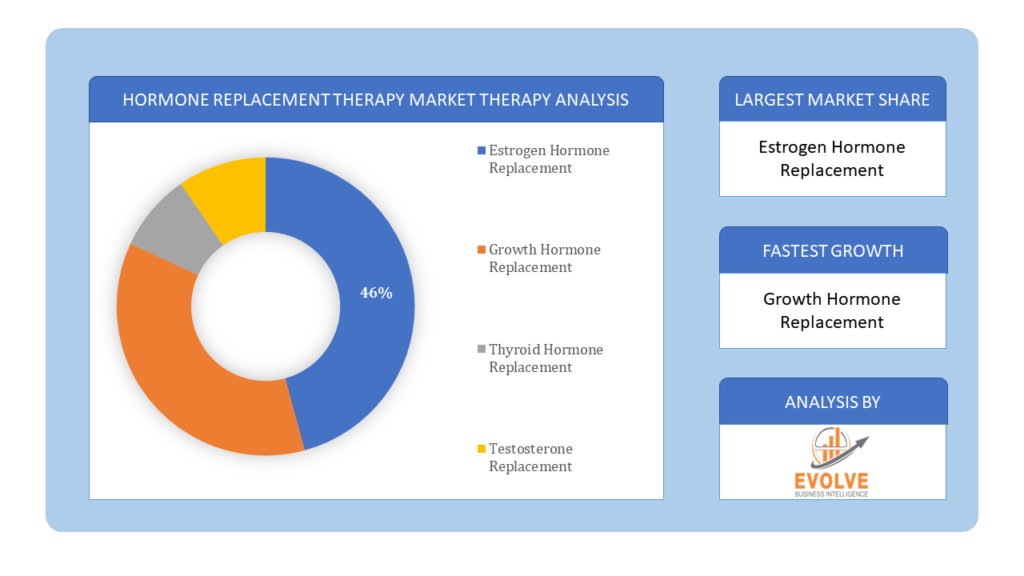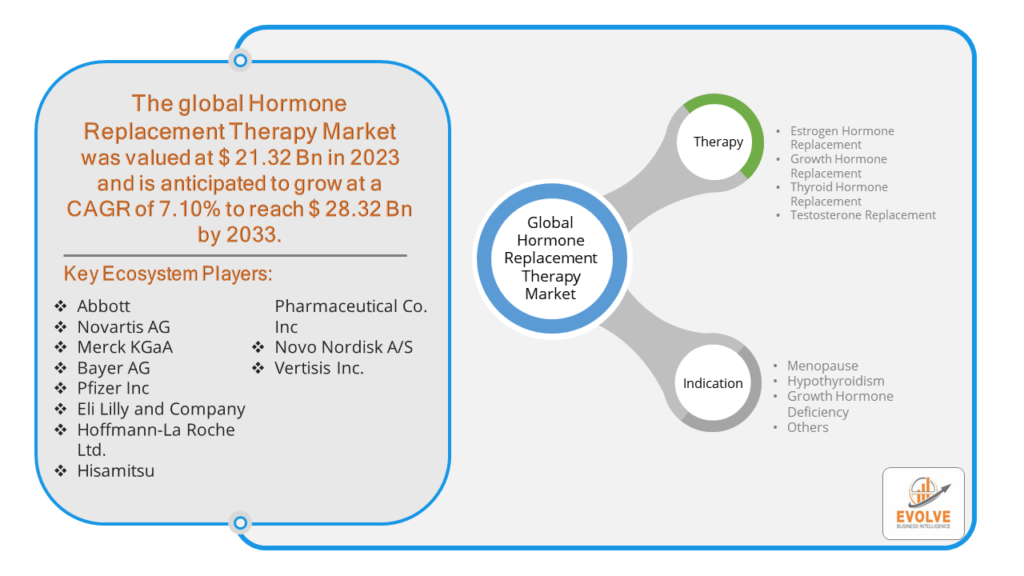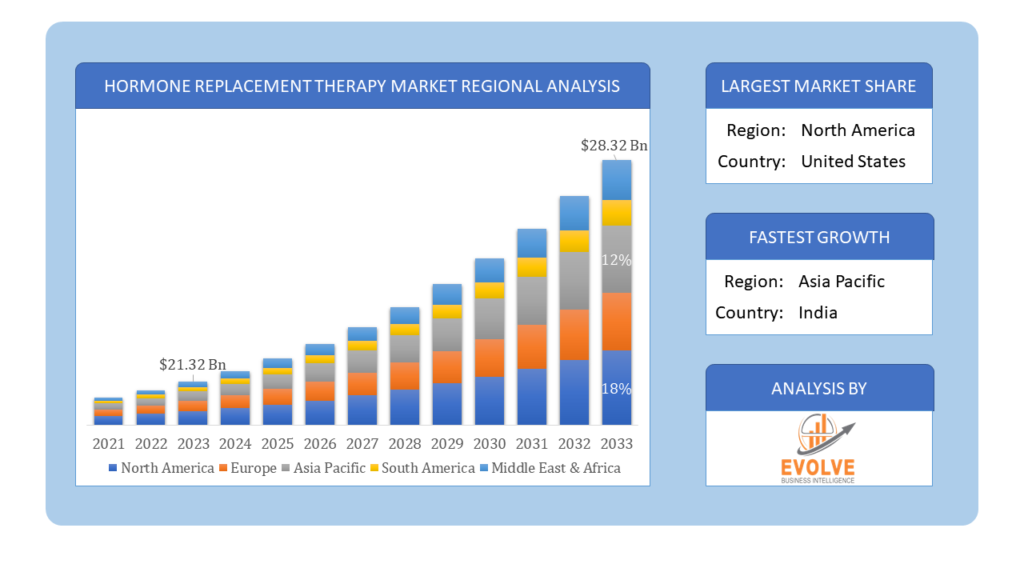Hormone Replacement Therapy Market Analysis and Global Forecast 2023-2033
$ 1,390.00 – $ 5,520.00Price range: $ 1,390.00 through $ 5,520.00
Hormone Replacement Therapy Market Research Report: Information By Therapy (Estrogen Hormone Replacement, Growth Hormone Replacement, Thyroid Hormone Replacement, Testosterone Replacement), By Indication (Menopause, Hypothyroidism, Growth Hormone Deficiency, Others), and by Region — Forecast till 2033
Page: 174
Hormone Replacement Therapy Market Overview
The Hormone Replacement Therapy Market Size is expected to reach USD 28.32 Billion by 2033. The Hormone Replacement Therapy Market industry size accounted for USD 21.32 Billion in 2023 and is expected to expand at a compound annual growth rate (CAGR) of 7.10% from 2023 to 2033. The Hormone Replacement Therapy (HRT) Market refers to the global market for medical treatments that aim to replenish or replace hormones in the body, typically used to alleviate symptoms associated with hormonal imbalances or deficiencies. This market includes various types of hormone therapies such as estrogen replacement therapy, testosterone replacement therapy, and other hormone treatments.
The HRT market is expected to grow as the demand for effective treatments for hormonal imbalances and deficiencies increases, driven by factors such as an aging population and advancements in medical technology. There is growing awareness of the benefits of HRT for treating menopausal symptoms, which is likely to lead to increased use of these therapies.
Global Hormone Replacement Therapy Market Synopsis
The COVID-19 pandemic had significant impacts on the Hormone Replacement Therapy (HRT) market. The global supply chain disruptions during the pandemic affected the production and distribution of hormone replacement therapies. Manufacturing plants faced shutdowns, and transportation restrictions led to delays in the delivery of raw materials and finished products. Due to lockdowns and fear of contracting the virus, many patients postponed or canceled their routine medical appointments. This led to a decrease in new prescriptions and renewals for hormone replacement therapies. The pandemic accelerated the adoption of telemedicine, allowing patients to consult with healthcare providers remotely. This facilitated continuous management of hormonal conditions and prescription renewals, even during lockdowns. The pandemic heightened awareness about health and wellness, leading some individuals to seek treatments for underlying conditions, including hormonal imbalances. Increased focus on maintaining overall health may have positively influenced the demand for HRT.
Hormone Replacement Therapy Market Dynamics
The major factors that have impacted the growth of Hormone Replacement Therapy Market are as follows:
Drivers:
Ø Rising Prevalence of Hormonal Imbalances
A growing number of women undergoing menopause and men experiencing hypogonadism (low testosterone levels) are seeking treatments to manage symptoms, driving the market for HRT. Advances in drug delivery technologies, such as transdermal patches, gels, and implants, have made HRT more convenient and effective, encouraging more patients to opt for these treatments. Development of bioidentical hormones that closely mimic natural hormones has improved the safety and efficacy of HRT, attracting more users. Increasing healthcare expenditure by governments and individuals supports the growth of the HRT market. As healthcare budgets expand, more resources are allocated to managing chronic conditions, including hormonal imbalances.
Restraint:
- Perception of High Cost of Treatment
Hormone replacement therapies can be expensive, including the cost of medications, regular monitoring, and associated healthcare services. This high cost can be a barrier for patients, especially those without insurance coverage or with limited financial resources. Some insurance plans may not fully cover HRT, leading to out-of-pocket expenses that patients may find difficult to afford. HRT requires personalized treatment plans tailored to individual needs, involving regular monitoring and adjustments. The complexity of treatment can be a deterrent for both patients and healthcare providers.
Opportunity:
⮚ Expanding Telemedicine
The rise of telemedicine and digital health platforms provides an opportunity to reach a broader patient base. Telehealth services can facilitate remote consultations, monitoring, and prescription renewals, making HRT more accessible. Educating the public about hormonal health and the benefits of HRT through awareness campaigns can reduce misconceptions and increase acceptance, driving market growth. Providing training for healthcare providers on the latest HRT developments can improve diagnosis and treatment rates. The increasing focus on health and wellness can drive demand for HRT as part of a broader approach to maintaining overall health and quality of life.
Hormone Replacement Therapy Market Segment Overview
By Therapy
 Based on Therapy, the market is segmented based on Estrogen Hormone Replacement, Growth Hormone Replacement, Thyroid Hormone Replacement and Testosterone Replacement. The Estrogen Hormone Replacement segment dominant the market. This is due to women’s increased usage of estradiol products to help them maintain hormonal balance after menopause or hysterectomy. Dryness, burning, itching, and pain during intercourse are some of the vaginal symptoms of menopause that can be alleviated by oestrogen replacement hormone therapy. Estrogen can be taken as a Estrogenpill, gel, Estrogen patch, lotion, or spray.
Based on Therapy, the market is segmented based on Estrogen Hormone Replacement, Growth Hormone Replacement, Thyroid Hormone Replacement and Testosterone Replacement. The Estrogen Hormone Replacement segment dominant the market. This is due to women’s increased usage of estradiol products to help them maintain hormonal balance after menopause or hysterectomy. Dryness, burning, itching, and pain during intercourse are some of the vaginal symptoms of menopause that can be alleviated by oestrogen replacement hormone therapy. Estrogen can be taken as a Estrogenpill, gel, Estrogen patch, lotion, or spray.
By Indication
Based on Indication, the market segment has been divided into the Menopause, Hypothyroidism, Growth Hormone Deficiency and Others. The Menopause segment dominant the market. Hormone treatment replaces a woman’s declining hormone levels with synthetic oestrogen and progestogen to lessen menopausal symptoms. One of the medications the government has licenced for treating menopausal symptoms is hormone therapy. Low oestrogen levels bring on these symptoms, and hormone replacement theory boosts the oestrogen, relieving the woman.
Global Hormone Replacement Therapy Market Regional Analysis
Based on region, the global Hormone Replacement Therapy Market has been divided into North America, Europe, Asia-Pacific, the Middle East & Africa, and Latin America. North America is projected to dominate the use of the Hormone Replacement Therapy Market followed by the Asia-Pacific and Europe regions.
 Hormone Replacement Therapy North America Market
Hormone Replacement Therapy North America Market
North America holds a dominant position in the Hormone Replacement Therapy Market. North America has High incidence of menopausal symptoms and age-related hormonal imbalances among the population. High levels of awareness about HRT benefits and acceptance among patients and healthcare providers. Presence of leading pharmaceutical companies and ongoing R&D activities.
Hormone Replacement Therapy Asia-Pacific Market
The Asia-Pacific region has indeed emerged as the fastest-growing market for the Hormone Replacement Therapy Market industry. Asia-Pacific region is rapidly growing demand for HRT driven by increasing awareness and improving healthcare infrastructure. Rising awareness about hormonal health and HRT benefits and Economic growth leading to increased healthcare expenditure. Expanding middle class with higher disposable incomes.
Competitive Landscape
The global Hormone Replacement Therapy Market is highly competitive, with numerous players offering a wide range of software solutions. The competitive landscape is characterized by the presence of established companies, as well as emerging startups and niche players. To increase their market position and attract a wide consumer base, the businesses are employing various strategies, such as product launches, and strategic alliances.
Prominent Players:
- Abbott
- Novartis AG
- Merck KGaA
- Bayer AG
- Pfizer Inc
- Eli Lilly and Company
- Hoffmann-La Roche Ltd.
- Hisamitsu Pharmaceutical Co. Inc
- Novo Nordisk A/S
- Vertisis Inc.
Key Development
In November 2021, a significant player, I-MAB Biopharma Co., Ltd., had agreed on an agreement with Jumpcan Pharmaceutical Group for the marketing and development of eftansomatropin alfa, named TJ101 in China, I-MAB Biopharma Co., Ltd. has partnered with Jumpcan Pharmaceutical Group. TJ101 is a long-acting recombinant human growth hormone intended to treat paediatric growth hormone insufficiency.
Scope of the Report
Global Hormone Replacement Therapy Market, by Therapy
- Estrogen Hormone Replacement
- Growth Hormone Replacement
- Thyroid Hormone Replacement
- Testosterone Replacement
Global Hormone Replacement Therapy Market, by Indication
- Menopause
- Hypothyroidism
- Growth Hormone Deficiency
- Others
Global Hormone Replacement Therapy Market, by Region
- North America
- US
- Canada
- Mexico
- Europe
- UK
- Germany
- France
- Italy
- Spain
- Benelux
- Nordic
- Rest of Europe
- Asia Pacific
- China
- Japan
- South Korea
- Indonesia
- Austalia
- Malaysia
- India
- Rest of Asia Pacific
- South America
- Brazil
- Argentina
- Rest of South America
- Middle East & Africa
- Saudi Arabia
- UAE
- Egypt
- South Africa
- Rest of Middle East & Africa
| Parameters | Indicators |
|---|---|
| Market Size | 2033: $28.32 Billion |
| CAGR | 7.10% CAGR (2023-2033) |
| Base year | 2022 |
| Forecast Period | 2023-2033 |
| Historical Data | 2021 |
| Report Coverage | Revenue Forecast, Competitive Landscape, Growth Factors, and Trends |
| Key Segmentations | Therapy, Indication |
| Geographies Covered | North America, Europe, Asia-Pacific, Latin America, Middle East, Africa |
| Key Vendors | Abbott, Novartis AG, Merck KGaA, Bayer AG, Pfizer Inc, Eli Lilly and Company, Hoffmann-La Roche Ltd., Hisamitsu Pharmaceutical Co. Inc, Novo Nordisk A/S and Vertisis Inc. |
| Key Market Opportunities | • Expanding Telemedicine • Lifestyle and Wellness Trends |
| Key Market Drivers | • Rising Prevalence of Hormonal Imbalances • Advances in Medical Technology |
REPORT CONTENT BRIEF:
- High-level analysis of the current and future Hormone Replacement Therapy Market trends and opportunities
- Detailed analysis of current market drivers, restraining factors, and opportunities in the future
- Hormone Replacement Therapy Market historical market size for the year 2021, and forecast from 2023 to 2033
- Hormone Replacement Therapy Market share analysis at each product level
- Competitor analysis with detailed insight into its product segment, Government & Defense strength, and strategies adopted.
- Identifies key strategies adopted including product launches and developments, mergers and acquisitions, joint ventures, collaborations, and partnerships as well as funding taken and investment done, among others.
- To identify and understand the various factors involved in the global Hormone Replacement Therapy Market affected by the pandemic
- To provide a detailed insight into the major companies operating in the market. The profiling will include the Government & Defense health of the company’s past 2-3 years with segmental and regional revenue breakup, product offering, recent developments, SWOT analysis, and key strategies.
Press Release

Global Pharmaceutical Manufacturing Market to Reach $1.38 Trillion by 2035 with 7.35% CAGR, New Research Shows

The Global Mammography Market Is Estimated To Record a CAGR of Around 10.29% During The Forecast Period

Glue Stick Market to Reach USD 2.35 Billion by 2034

Podiatry Service Market to Reach USD 11.88 Billion by 2034

Microfluidics Technology Market to Reach USD 32.58 Billion by 2034

Ferric Chloride Market to Reach USD 10.65 Billion by 2034

Family Practice EMR Software Market to Reach USD 21.52 Billion by 2034

Electric Hairbrush Market to Reach USD 15.95 Billion by 2034

Daily Bamboo Products Market to Reach USD 143.52 Billion by 2034

Cross-border E-commerce Logistics Market to Reach USD 112.65 Billion by 2034
Frequently Asked Questions (FAQ)
What is the projected market size for Hormone Replacement Therapy by 2033?
The Hormone Replacement Therapy (HRT) market size is expected to reach USD 28.32 billion by 2033.
What is the expected CAGR for the HRT market from 2023 to 2033?
The HRT market is anticipated to expand at a compound annual growth rate (CAGR) of 7.10% from 2023 to 2033
Which region dominates the Hormone Replacement Therapy market?
North America is projected to dominate the HRT market, driven by high awareness and prevalence of hormonal imbalances
How did COVID-19 impact the Hormone Replacement Therapy market?
COVID-19 caused supply chain disruptions and delayed medical appointments, but also accelerated telemedicine adoption, aiding continuous patient management
What are the main drivers for the growth of the HRT market?
The rising prevalence of hormonal imbalances and advancements in medical technology are key drivers of the HRT market growth
Table of Content
Chapter 1. Executive Summary Chapter 2. Scope Of The Study 2.1. Market Definition 2.2. Scope Of The Study 2.2.1. Objectives of Report 2.2.2. Limitations 2.3. Market Structure Chapter 3. Evolve BI Methodology Chapter 4. Market Insights and Trends 4.1. Supply/ Value Chain Analysis 4.1.1. Raw End Users Providers 4.1.2. Manufacturing Process 4.1.3. Distributors/Retailers 4.1.4. End-Use Industry 4.2. Porter’s Five Forces Analysis 4.2.1. Threat Of New Entrants 4.2.2. Bargaining Power Of Buyers 4.2.3. Bargaining Power Of Suppliers 4.2.4. Threat Of Substitutes 4.2.5. Industry Rivalry 4.3. Impact Of COVID-19 on the Hormone Replacement Therapy Market 4.3.1. Impact on Market Size 4.3.2. End-Use Industry Trend, Preferences, and Budget Impact 4.3.3. Regulatory Framework/Government Policies 4.3.4. Key Players' Strategy to Tackle Negative Impact 4.3.5. Opportunity Window 4.4. Technology Overview 12.28. Macro factor 4.6. Micro Factor 4.7. Demand Supply Gap Analysis of the Hormone Replacement Therapy Market 4.8. Import Analysis of the Hormone Replacement Therapy Market 4.9. Export Analysis of the Hormone Replacement Therapy Market Chapter 5. Market Dynamics 5.1. Introduction 5.2. DROC Analysis 5.2.1. Drivers 5.2.2. Restraints 5.2.3. Opportunities 5.2.4. Challenges 5.3. Patent Analysis 5.4. Industry Roadmap 5.5. Parent/Peer Market Analysis Chapter 6. Global Hormone Replacement Therapy Market, By Therapy 6.1. Introduction 6.2. Estrogen Hormone Replacement 6.3. Growth Hormone Replacement 6.4. Thyroid Hormone Replacement 6.5. Testosterone Replacement Chapter 7. Global Hormone Replacement Therapy Market, By Indication 7.1. Introduction 7.2. Menopause 7.3. Hypothyroidism 7.4 Growth Hormone Deficiency 7.5 Others Chapter 8. Global Hormone Replacement Therapy Market, By Region 8.1. Introduction 8.2. North America 8.2.1. Introduction 8.2.2. Driving Factors, Opportunity Analyzed, and Key Trends 8.2.3. Market Size and Forecast, By Country, 2023-2033 8.2.4. Market Size and Forecast, By Therapy, 2023-2033 8.2.5. Market Size and Forecast, By Indication, 2023-2033 8.2.6. US 8.2.6.1. Introduction 8.2.6.2. Driving Factors, Opportunity Analyzed, and Key Trends 8.2.6.3. Market Size and Forecast, By Therapy, 2023-2033 8.2.6.4. Market Size and Forecast, By Indication, 2023-2033 8.2.7. Canada 8.2.7.1. Introduction 8.2.7.2. Driving Factors, Opportunity Analyzed, and Key Trends 8.2.7.4. Market Size and Forecast, By Therapy, 2023-2033 8.2.7.5. Market Size and Forecast, By Indication, 2023-2033 8.3. Europe 8.3.1. Introduction 8.3.2. Driving Factors, Opportunity Analyzed, and Key Trends 8.3.3. Market Size and Forecast, By Country, 2023-2033 8.3.4. Market Size and Forecast, By Therapy, 2023-2033 8.3.5. Market Size and Forecast, By Indication, 2023-2033 8.3.6. Germany 8.3.6.1. Introduction 8.3.6.2. Driving Factors, Opportunity Analyzed, and Key Trends 8.3.6.3. Market Size and Forecast, By Therapy, 2023-2033 8.3.6.4. Market Size and Forecast, By Indication, 2023-2033 8.3.7. France 8.3.7.1. Introduction 8.3.7.2. Driving Factors, Opportunity Analyzed, and Key Trends 8.3.7.3. Market Size and Forecast, By Therapy, 2023-2033 8.3.7.4. Market Size and Forecast, By Indication, 2023-2033 8.3.8. UK 8.3.8.1. Introduction 8.3.8.2. Driving Factors, Opportunity Analyzed, and Key Trends 8.3.8.3. Market Size and Forecast, By Therapy, 2023-2033 8.3.8.4. Market Size and Forecast, By Indication, 2023-2033 8.3.9. Italy 8.3.9.1. Introduction 8.3.9.2. Driving Factors, Opportunity Analyzed, and Key Trends 8.3.9.3. Market Size and Forecast, By Therapy, 2023-2033 8.3.9.4. Market Size and Forecast, By Indication, 2023-2033 8.3.11. Rest Of Europe 8.3.11.1. Introduction 8.3.11.2. Driving Factors, Opportunity Analyzed, and Key Trends 8.3.11.3. Market Size and Forecast, By Therapy, 2023-2033 8.3.11.4. Market Size and Forecast, By Indication, 2023-2033 8.4. Asia-Pacific 8.4.1. Introduction 8.4.2. Driving Factors, Opportunity Analyzed, and Key Trends 8.4.3. Market Size and Forecast, By Country, 2023-2033 8.4.4. Market Size and Forecast, By Therapy, 2023-2033 8.12.28. Market Size and Forecast, By Indication, 2023-2033 8.4.6. China 8.4.6.1. Introduction 8.4.6.2. Driving Factors, Opportunity Analyzed, and Key Trends 8.4.6.3. Market Size and Forecast, By Therapy, 2023-2033 8.4.6.4. Market Size and Forecast, By Indication, 2023-2033 8.4.7. India 8.4.7.1. Introduction 8.4.7.2. Driving Factors, Opportunity Analyzed, and Key Trends 8.4.7.3. Market Size and Forecast, By Therapy, 2023-2033 8.4.7.4. Market Size and Forecast, By Indication, 2023-2033 8.4.8. Japan 8.4.8.1. Introduction 8.4.8.2. Driving Factors, Opportunity Analyzed, and Key Trends 8.4.8.3. Market Size and Forecast, By Therapy, 2023-2033 8.4.8.4. Market Size and Forecast, By Indication, 2023-2033 8.4.9. South Korea 8.4.9.1. Introduction 8.4.9.2. Driving Factors, Opportunity Analyzed, and Key Trends 8.4.9.3. Market Size and Forecast, By Therapy, 2023-2033 8.4.9.4. Market Size and Forecast, By Indication, 2023-2033 8.4.10. Rest Of Asia-Pacific 8.4.10.1. Introduction 8.4.10.2. Driving Factors, Opportunity Analyzed, and Key Trends 8.4.10.3. Market Size and Forecast, By Therapy, 2023-2033 8.4.10.4. Market Size and Forecast, By Indication, 2023-2033 8.5. Rest Of The World (RoW) 8.5.1. Introduction 8.5.2. Driving Factors, Opportunity Analyzed, and Key Trends 8.5.3. Market Size and Forecast, By Therapy, 2023-2033 8.5.4. Market Size and Forecast, By Indication, 2023-2033 Chapter 9. Company Landscape 9.1. Introduction 9.2. Vendor Share Analysis 9.3. Key Development Analysis 9.4. Competitor Dashboard Chapter 10. Company Profiles 10.1. Abbott 10.1.1. Business Overview 10.1.2. Government & Defense Analysis 10.1.2.1. Government & Defense – Existing/Funding 10.1.3. Product Portfolio 10.1.4. Recent Development and Strategies Adopted 10.1.5. SWOT Analysis 10.2. Novartis AG 10.2.1. Business Overview 10.2.2. Government & Defense Analysis 10.2.2.1. Government & Defense – Existing/Funding 10.2.3. Product Portfolio 10.2.4. Recent Development and Strategies Adopted 10.2.5. SWOT Analysis 10.3. Merck KGaA 10.3.1. Business Overview 10.3.2. Government & Defense Analysis 10.3.2.1. Government & Defense – Existing/Funding 10.3.3. Product Portfolio 10.3.4. Recent Development and Strategies Adopted 10.3.5. SWOT Analysis 10.4. Bayer AG 10.4.1. Business Overview 10.4.2. Government & Defense Analysis 10.4.2.1. Government & Defense – Existing/Funding 10.4.3. Product Portfolio 10.4.4. Recent Development and Strategies Adopted 10.12.28. SWOT Analysis 10.5. Pfizer Inc 10.5.1. Business Overview 10.5.2. Government & Defense Analysis 10.5.2.1. Government & Defense – Existing/Funding 10.5.3. Product Portfolio 10.5.4. Recent Development and Strategies Adopted 10.5.5. SWOT Analysis 10.6. Eli Lilly and Company 10.6.1. Business Overview 10.6.2. Government & Defense Analysis 10.6.2.1. Government & Defense – Existing/Funding 10.6.3. Product Portfolio 10.6.4. Recent Development and Strategies Adopted 10.6.5. SWOT Analysis 10.7. Hoffmann-La Roche Ltd. 10.7.1. Business Overview 10.7.2. Government & Defense Analysis 10.7.2.1. Government & Defense – Existing/Funding 10.7.3. Product Portfolio 10.7.4. Recent Development and Strategies Adopted 10.7.5. SWOT Analysis 10.8 Hisamitsu Pharmaceutical Co. Inc 10.8.1. Business Overview 10.8.2. Government & Defense Analysis 10.8.2.1. Government & Defense – Existing/Funding 10.8.3. Product Portfolio 10.8.4. Recent Development and Strategies Adopted 10.8.5. SWOT Analysis 10.9 Novo Nordisk A/S 10.9.1. Business Overview 10.9.2. Government & Defense Analysis 10.9.2.1. Government & Defense – Existing/Funding 10.9.3. Product Portfolio 10.9.4. Recent Development and Strategies Adopted 10.9.5. SWOT Analysis 10.10. Vertisis Inc 10.10.1. Business Overview 10.10.2. Government & Defense Analysis 10.10.2.1. Government & Defense – Existing/Funding 10.10.3. Product Portfolio 10.10.4. Recent Development and Strategies Adopted 10.10.5. SWOT Analysis
Connect to Analyst
Research Methodology








